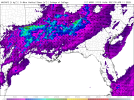I did some digging and found a couple studies that calculate the kinetic energy of tornadoes. Thought you might be interested? For reference, the Hiroshima bomb had a blast yield of 63 Trillion Joules (TJ).
This study concluded the average kinetic energy of an EF5 tornado is 50.4 TJ. Funnily enough, the 2011 Sawyerville-Eoline EF3 released the most energy out of all the tornadoes they calculated with a whopping 125 TJ. The Hackleburg-Phil Campbell EF5 was #2 with 100 TJ of energy.
This study is much more conservative and says only 1% of tornadoes exceed 31.9 TJ. However, their top 10 tornadoes released WAY more energy than the first study's top 10. They calculated the 2010 Yazoo City EF4 released over 516 TJ of energy (8.19 X the Hiroshima blast)! As long as we're entertaining the electro-magnet theory, this list is really bizarre because their top 5 tornadoes all did some uniquely incredible damage to steel objects/structures.
View attachment 39554
The biggest issue with both these studies is they used EF scale wind speeds in their calculations instead of DOW or NEXRAD measurements, which are significantly higher. Considering the exponential relationship between wind speed and kinetic energy release, these studies are likely both underestimating the kinetic energy of tornadoes by orders of magnitude.
For anyone interested, here's a graph showing the relationship between wind speeds and kinetic energy. The kinetic energy of a 1 KG object moving at 200 mph (EF5 threshold) is 4050 J, and 260 mph (F5 threshold) is 6845 J. That's a 70% increase in energy with only a 30% increase in wind speed.
View attachment 39553
Does this help give some clarity on your energy questions
@slenker?








